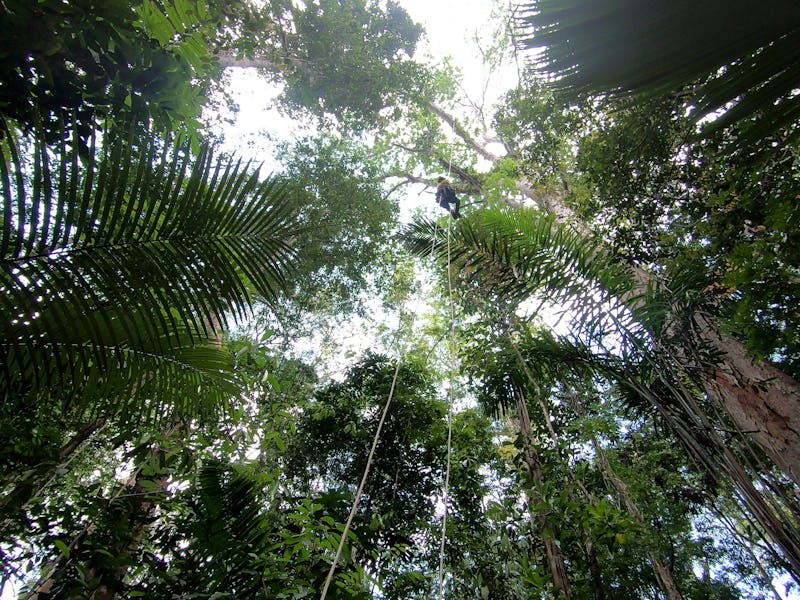The Amazon’s Tallest Trees Are Safe (for Now)
“We never imagined this tree size in the Amazon."

As wildfires raged last month in the Amazon, a team of researchers was busy tracking down the rainforest’s tallest trees. During a 10-day journey that included trekking up the Jari River in northeastern Brazil, the researchers were without cell phone service, and had no idea that thousands of human-driven fires were blazing across parts of the vast rainforest.
The team recorded the tallest-ever tree in Brazil, a species called Dinizia excelsa, which stands at 88 meters, or 288 feet. (For reference, the Statue of Liberty tops out at 305 feet, including its base.) The record-setter is part of a grove of at least 15 trees, all more than 70 meters tall.
Eric Bastos Gorgens, a forest researcher at the Federal University of Jequitinhonha and Mucuri Valleys in Brazil who led the research group, said that height is unheard of in Brazil.
“We never imagined this tree size in the Amazon,” Gorgens tells Inverse.
Before the August venture into the rainforest, Gorgens had already measured the lofty trees from afar. He led research using aerial laser scanning technology called Light Detection and Ranging, or LiDAR, which was published recently in the journal Frontiers in Ecology and the Environment.
“The tropical rainforests of South America are not traditionally thought to harbor trees as tall as those on other continents,” the authors write. “However, we present new evidence of giant trees in the Amazon basin.”
The scanning’s primary purpose is to measure trees’ biomass, which in turn allows researchers to calculate the forests’ ability to store carbon. Finding giant trees is an added bonus. Apart from breaking records, “the discovery of giant trees improves our understanding of their effects on global carbon dynamics and on biodiversity,” the authors write.
Gorgens led a team of 31 into the Amazon basin to confirm the heights with in-person data.
The team included two climbers, who scaled the tall trunks to take measurements, as well as 12 members of the São Francisco do Iratapuru community, who live near the Jari River and helped the researchers navigate the river and forest.
The researchers camped out in a remote area of the Amazon rainforest.
As the researchers camped out in the remote groves among sky-scraping trees, the world’s attention turned to fires across parts of the Amazon. A growing number of fires — they increased in Brazil by 85 percent in 2019, according to the country’s space agency — are the result of illegal forest clearing to create land for farming, as Inverse reported in August. Deliberately set fires can spread easily in the dry season.
But the fires that captured global attention were miles away, “so we were completely unaware of the fires while we were in the forest,” says Toby Jackson, a postdoctoral researcher in the Department of Plant Science at the University of Cambridge. The team returned from their journey, which took place August 14 to 24, to text messages from concerned family members who had seen the fires on the news.
Since 2014, the rate at which Brazil has lost Amazonian forest has expanded by 60 percent, due in part to the dismantling of Brazilian environmental regulations since the 2018 election of President Jair Bolsonaro.
Environmental leaders, including former environment ministers in Brazil, have called out Bolsonaro’s weakening of environmental protections. Internationally, Ireland’s Prime Minister Leo Varadkar and French President Emmanuel Macron have criticized Brazilian leadership over its failure to tighten environmental regulations. And Germany and Norway ended their support of the Amazon Fund for forest preservation.
The Amazon’s tallest trees are safe for the time being, as they’re located inside a protected area called Paru State Forest. And the remoteness of their location helps protect from the immediate threat of logging, Jackson says.
The research team included 12 members of the São Francisco do Iratapuru community, who live near the Jari River.
“It took us five days to get there by river, so I don’t think it would be economically feasible to start logging there,” he says.
Gorgens says his next challenge is to understand how these Dinizia excelsa were able to reach such heights, and why this particular region is capable of supporting the development of giant trees.
He and the Frontiers in Ecology and the Environment paper’s co-authors suggest that towering trees can further the public’s commitment to conservation.
“Large trees are particularly important as a source of inspiration to the general public, often playing a key role in campaigns to conserve forests,” the authors write. “Furthermore, their dynamics are important for the maintenance of plant and animal diversity, and they contribute disproportionately to biomass and productivity.”